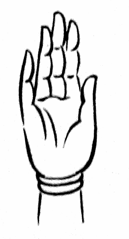Abhayamudra


The abhayamudra (
romanized: abhayamudrā, lit. 'gesture of fearlessness')[2] is a mudra (gesture) that is the gesture of reassurance and safety, which dispels fear and accords divine protection and bliss in Hinduism, Buddhism, and other Indian religions. The right hand is held upright, and the palm is facing outwards.[3] This is one of the earliest mudras found depicted on a number of Hindu, Buddhist, Jain, and Sikh
images.
Description
The abhayamudra represents protection, peace, benevolence and the dispelling of fear. A form of the Hindu god
Walking Buddha
, often shown having both hands making a double abhayamudra that is uniform.

The abhayamudra was probably used before the onset of Buddhism as a symbol of good intentions proposing friendship when approaching strangers. In the art of Gandhara, it is present when showing the action of preaching. It was also used in China during the Northern Wei and Sui eras of the 4th and 7th centuries.[citation needed]
The gesture was used by
Buddha
with his right hand in abhayamudra.
References
- ISBN 978-0-226-06456-7.
- ISBN 9780691157863.
- ^ "Abhaya Mudra". 17 March 2015. Archived from the original on 18 July 2015. Retrieved 10 February 2015.
- ^ From Dhammapada, Buddhacharita, and Arśapraśamanasūtra
Bibliography
- Dallapiccola, Anna L. (2002). Dictionary of Hindu Lore and Legend. Thames & Hudson. ISBN 978-0-500-28402-5.
External links
 Media related to Abhayamudra at Wikimedia Commons
Media related to Abhayamudra at Wikimedia Commons
